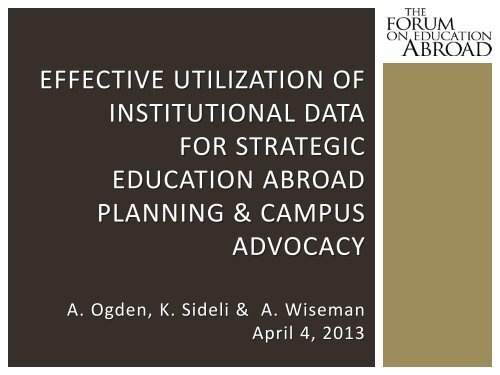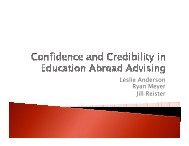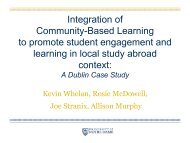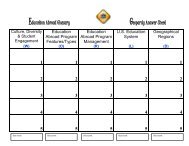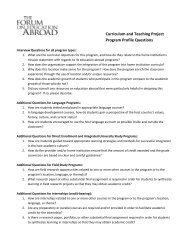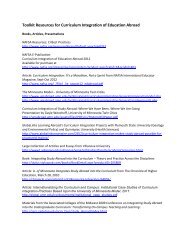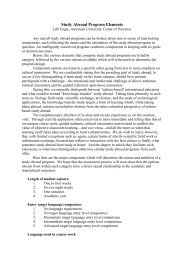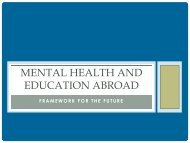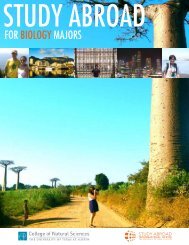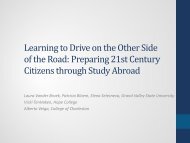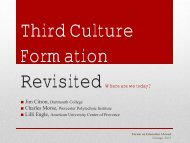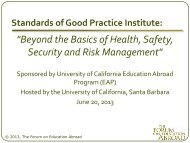effective utilization of institutional data for strategic education abroad ...
effective utilization of institutional data for strategic education abroad ...
effective utilization of institutional data for strategic education abroad ...
You also want an ePaper? Increase the reach of your titles
YUMPU automatically turns print PDFs into web optimized ePapers that Google loves.
EFFECTIVE UTILIZATION OF<br />
INSTITUTIONAL DATA<br />
FOR STRATEGIC<br />
EDUCATION ABROAD<br />
PLANNING & CAMPUS<br />
ADVOCACY<br />
A. Ogden, K. Sideli & A. Wiseman<br />
April 4, 2013
SESSION OVERVIEW<br />
Welcome & introductions<br />
Session objectives & Needs assessment<br />
Common issues and applicable <strong>data</strong>sets &<br />
approaches<br />
Trading places: Group activity<br />
Discussion & resources<br />
What are your most common<br />
requests <strong>for</strong> <strong>data</strong>?
SESSION OBJECTIVES<br />
To provide an introduction to the importance <strong>of</strong> accurately<br />
gathering and <strong>effective</strong>ly utilizing <strong>institutional</strong> and external<br />
<strong>data</strong> <strong>for</strong> <strong>strategic</strong> planning and campus-based advocacy.<br />
To introduce commonly used <strong>data</strong>sets readily available at<br />
most institutions and discuss best practices <strong>for</strong> accessing and<br />
reframing these <strong>data</strong>sets <strong>for</strong> <strong>strategic</strong> purposes.<br />
To provide suggestions <strong>for</strong> <strong>effective</strong>ly partnering with<br />
<strong>strategic</strong> <strong>of</strong>fices or units to compile new <strong>data</strong> and examples<br />
<strong>of</strong> when such partnerships have led to policy revision and<br />
development.<br />
To present key challenges commonly shared by <strong>education</strong><br />
<strong>abroad</strong> pr<strong>of</strong>essionals and the <strong>data</strong>sets that could further<br />
bolster positions or reframe these issues.
TOP SEVEN REQUESTS FOR DATA<br />
#1 Who are our underrepresented populations and how do we<br />
foster greater inclusion?<br />
#2 What are the college/dept.-specific priorities <strong>for</strong> <strong>education</strong><br />
<strong>abroad</strong> and what info. is needed?<br />
#3 Is our <strong>education</strong> <strong>abroad</strong> portfolio responsive to our<br />
<strong>institutional</strong> demographic?<br />
#4 Does <strong>education</strong> <strong>abroad</strong> impact persistence/ retention?<br />
How so?<br />
#5 What role does <strong>education</strong> <strong>abroad</strong> have in student<br />
recruitment and admissions?<br />
#6 How do we monitor non-credit bearing international travel?<br />
Why should we?<br />
#7 How does financial need impact <strong>education</strong> <strong>abroad</strong><br />
enrollment trends?
ISSUE 1:7 – WHO’S WHO?<br />
Who are our underrepresented populations and how do<br />
we foster greater inclusion?<br />
Race/Ethnicity<br />
% <strong>of</strong> 2010-11<br />
EA Enrol.<br />
% <strong>of</strong><br />
UK Enrol.<br />
Nat. Avg.<br />
(IIE, 2011)<br />
African - American 6.6% 6.5% 4.7%<br />
Asian-American/ Pacific Islander 3.6% 2.7% 7.9%<br />
Caucasian/White Non-Hispanic 80.5% 79% 78.7%<br />
Hispanic - American 2.2% 1.8% 6.4%<br />
Multiracial 0.9% 0.6% 1.9%<br />
Native Amer./ Alaskan Native 0.2% 0.2% 0.5%<br />
Prefer Not to Answer/Other 5.9% 4.2% n/a<br />
Nonresident Alien n/a 5.0% n/a<br />
Other 0.2% n/a n/a
ISSUE 1:7 – WHO’S WHO?<br />
Who are our underrepresented populations and how do<br />
we foster greater inclusion?<br />
Race/Ethnicity<br />
% <strong>of</strong> 2010-11<br />
EA Enrol.<br />
% <strong>of</strong><br />
UK Enrol.<br />
Nat. Avg.<br />
(IIE, 2011)<br />
Male 35.6% 50.8% 36.5%<br />
Female 64.4% 49.2% 63.5%<br />
First Generation 9.3% 23.2% n/a<br />
Not First Generation 47.3% 76.8% n/a<br />
Unreported 43.4% 0% n/a<br />
Undergraduate 92.0% 71.7% n/a<br />
Graduate 8.0% 28.3% n/a<br />
Honors 14.6% 4.0% n/a<br />
Not Honors 85.4% 96.0% n/a<br />
Transfer 11.3% 20.9% n/a<br />
Not Transfer 88.7% 79.1% n/a
ISSUE 2:7 – PLATINUM RULE<br />
What are the<br />
college/dept.-specific<br />
priorities <strong>for</strong> <strong>education</strong><br />
<strong>abroad</strong> and what info. is<br />
needed?
ISSUE 2:7 – PLATINUM RULE<br />
What are the college/dept.-specific priorities <strong>for</strong><br />
<strong>education</strong> <strong>abroad</strong> and what info. is needed?
ISSUE 2:7 – PLATINUM RULE<br />
What are the college/dept.-specific priorities <strong>for</strong><br />
<strong>education</strong> <strong>abroad</strong> and what info. is needed?<br />
School & college-specific <strong>education</strong> <strong>abroad</strong> enrollment<br />
<strong>data</strong><br />
Coding participation rates
ISSUE 2:7 – PLATINUM RULE<br />
What are the college/dept.-specific priorities <strong>for</strong><br />
<strong>education</strong> <strong>abroad</strong> and what info. is needed?<br />
Regularly documenting department level participation<br />
Name Major(s) Program Provider Location<br />
Doe, John<br />
History BA,<br />
Anthropology BA,<br />
Germanic Studies<br />
BA<br />
Freiburg--IU<br />
Spring Semester<br />
Program<br />
Office <strong>of</strong> Overseas<br />
Study<br />
Germany
ISSUE 3:7 – DOES THE SHOE FIT?<br />
Is our <strong>education</strong> <strong>abroad</strong> portfolio responsive to our<br />
<strong>institutional</strong> demographic?<br />
SAT Reasoning Test (pre-college plans)<br />
24% planned to study <strong>abroad</strong> in college<br />
[female, underrepresented groups, non-residents, higher<br />
SATs, college-educated parents, multicultural activities in<br />
high school]<br />
NSSE results (correlated w/SAT Reasoning Test) 1st Year<br />
Plans<br />
55% planned to study <strong>abroad</strong><br />
[female, underrepresented, non-residents, no financial aid<br />
had pre-college plans to study <strong>abroad</strong> - higher SATs – in<br />
first year exposure to diverse others and had reflective<br />
learning<br />
Indiana University Institutional Study, 2009
ISSUE 3:7 – DOES THE SHOE FIT?<br />
Is our <strong>education</strong> <strong>abroad</strong> portfolio responsive to our<br />
<strong>institutional</strong> demographic?<br />
IU Institutional Data: Study Abroad Participation<br />
23% planned to study <strong>abroad</strong> but only 1/3 <strong>of</strong> that group<br />
did<br />
14% had no pre-college plans to study <strong>abroad</strong> but did so<br />
female - non-residents – no financial aid –<br />
college-educated parents<br />
majors: business/communications – social sciences – A&H
ISSUE 3:7 – DOES THE SHOE FIT?<br />
Is our <strong>education</strong> <strong>abroad</strong> portfolio responsive to our<br />
<strong>institutional</strong> demographic?<br />
Impact at IU <strong>of</strong> analyzing participants residency<br />
classification <strong>data</strong><br />
expansion <strong>of</strong> exchanges<br />
development <strong>of</strong> discipline-specific programs<br />
need <strong>for</strong> <strong>institutional</strong> administered options<br />
advocacy <strong>for</strong> residency related gift aid<br />
Non residents comprise:<br />
2/3 participants on external programs<br />
1/2 participants on co-sponsored programs<br />
1/3 participants on administered programs
ISSUE 3:7 – DOES THE SHOE FIT?<br />
Is our <strong>education</strong> <strong>abroad</strong> portfolio responsive to our<br />
<strong>institutional</strong> demographic?<br />
W<strong>of</strong><strong>for</strong>d regularly engages in a multi-layered review <strong>of</strong><br />
NSSE <strong>data</strong><br />
Various cohorts are examined en action is taken based<br />
on the finding<br />
Compare and correlate NSSE and CIRP<br />
Discuss and evaluate unexpected findings<br />
Implement changes in programming and assess the<br />
impact <strong>of</strong> such a change
ISSUE 3:7 – DOES THE SHOE FIT?<br />
Is our <strong>education</strong> <strong>abroad</strong> portfolio responsive to our<br />
<strong>institutional</strong> demographic?<br />
90<br />
80<br />
70<br />
60<br />
50<br />
40<br />
30<br />
20<br />
10<br />
0<br />
Level <strong>of</strong><br />
Academic<br />
Challenge<br />
Active and<br />
Collaborative<br />
Learning<br />
Student Faculty<br />
Interction<br />
Enriching<br />
Educational<br />
Experiences<br />
Supportive<br />
Campus<br />
Environment<br />
Both<br />
Foreign Language<br />
Biology<br />
Neither
ISSUE 4:7 – ONWARD TO GRADUATION<br />
Does <strong>education</strong> <strong>abroad</strong> impact persistence/ retention?<br />
How so?<br />
In order to study persistence/retention W<strong>of</strong><strong>for</strong>d<br />
reviews NSSE <strong>data</strong> (ie. Supportive Campus<br />
Environment)<br />
Various cohorts are examined (ie. Students who have<br />
studied <strong>abroad</strong>, short-term, long-term)<br />
Actual 4, 5, 6 year graduation rates<br />
Further study focuses on specialized programs,<br />
scholarship programs that encourage study <strong>abroad</strong> (ie.<br />
21 st Century Boarding Pass)
ISSUE 4:7 – ONWARD TO GRADUATION<br />
Does <strong>education</strong> <strong>abroad</strong> impact persistence/ retention?<br />
How so?<br />
100%<br />
90%<br />
80%<br />
70%<br />
60%<br />
50%<br />
40%<br />
30%<br />
20%<br />
10%<br />
0%<br />
62.52%<br />
78.20%<br />
92.96%<br />
No Study Abroad All W<strong>of</strong><strong>for</strong>d Students Interim and/or<br />
Semester Abroad<br />
94.44%<br />
Semester Abroad
ISSUE 4:7 – ONWARD TO GRADUATION<br />
Survey <strong>of</strong> 21st Does <strong>education</strong> <strong>abroad</strong> impact persistence/ retention?<br />
How so?<br />
C Boarding Pass recipients since 2008:<br />
89% couldn’t participate without this funding<br />
44% wouldn’t major in FL without this immersion<br />
81% went on to major in a language<br />
56% declared double majors<br />
6% triple majors<br />
100% said 21 st C greatly affected their goals<br />
88% said 21 st C affected postgraduate goals<br />
71% went on to study <strong>abroad</strong> <strong>for</strong> a semester
ISSUE 4:7 – ONWARD TO GRADUATION<br />
Does <strong>education</strong> <strong>abroad</strong> impact persistence/ retention?<br />
How so?<br />
Skills Gained<br />
Independence/personal<br />
growth: 96.6%<br />
Critical thinking: 48.3%<br />
Problem solving: 55.2%<br />
Cross-cultural skills:<br />
93.1%<br />
Improved language<br />
pr<strong>of</strong>iciency: 100%
ISSUE 4:7 – ONWARD TO GRADUATION<br />
“The opportunity to leave one's home, step out <strong>of</strong> one's<br />
com<strong>for</strong>t zone, and experience something completely new<br />
and different is one <strong>of</strong> the most important <strong>education</strong>al<br />
tools that a school can <strong>of</strong>fer a student.<br />
As a 21st Century Boarding Pass recipient, I can't be more<br />
grateful <strong>for</strong> the chance I had to go <strong>abroad</strong>, and already in<br />
the short time <strong>of</strong> a little over one year is the change in my<br />
life path/plan very noticeable.<br />
I hope that all W<strong>of</strong><strong>for</strong>d students will have the chance that I<br />
had to apply themselves and explore somewhere new.”<br />
Liebe Grüße aus Berlin, David
ISSUE 4:7 – ONWARD TO GRADUATION<br />
Does <strong>education</strong> <strong>abroad</strong> impact persistence/ retention?<br />
How so?<br />
Graduate Rates by Education Abroad - First-time, Full-time Freshmen<br />
2000<br />
2001<br />
2002<br />
2003<br />
2004<br />
2005<br />
2006<br />
2007<br />
Cohort<br />
First Fall Enrollment<br />
N<br />
4 Year Degree<br />
Completion %<br />
5 Year Degree<br />
Completion %<br />
6 Year Degree<br />
Completion %<br />
Study Abroad=No 2913 29.4 52.1 57.9<br />
Study Abroad=Yes 58 48.3 82.8 89.7<br />
All 2971 29.8 52.7 58.6<br />
Study Abroad=No 3067 30.0 52.8 60.3<br />
Study Abroad=Yes 62 46.8 75.8 82.3<br />
All 3129 30.4 53.3 60.7<br />
Study Abroad=No 3574 27.5 49.8 56.0<br />
Study Abroad=Yes 130 47.7 77.7 86.2<br />
All 3704 28.2 50.8 57.0<br />
Study Abroad=No 3513 30.8 52.7 57.0<br />
Study Abroad=Yes 170 45.9 82.9 90.6<br />
All 3683 31.5 54.1 58.6<br />
Study Abroad=No 3712 30.8 50.6 55.0<br />
Study Abroad=Yes 223 59.6 91.5 95.5<br />
All 3935 32.4 52.9 57.3<br />
Study Abroad=No 3493 31.5 51.1 55.5<br />
Study Abroad=Yes 331 57.7 88.2 93.4<br />
All 3824 33.8 54.3 58.8<br />
Study Abroad=No 3774 28.0 48.6<br />
Study Abroad=Yes 344 57.0 85.8<br />
All 4118 30.4 51.7<br />
Study Abroad=No 3474 29.9<br />
Study Abroad=Yes 361 64.0<br />
All 3835 33.1
ISSUE 4:7 – ONWARD TO GRADUATION<br />
Does <strong>education</strong> <strong>abroad</strong> impact persistence/ retention?<br />
How so?<br />
Year Graduated<br />
Average number <strong>of</strong> years to graduation: Students who started at UK as first-time full-time students<br />
Study Abroad Participants All Other Students<br />
N Mean N Mean<br />
Mean<br />
Difference<br />
Adjusted<br />
Mean<br />
Difference*<br />
t-test <strong>for</strong><br />
comparing<br />
adjusted<br />
means p-value<br />
2011-2012 365 4.59 2155 4.92 -0.33 -0.06 -0.85 0.3967<br />
2010-2011 356 4.49 2130 4.90 -0.41 -0.14 -2.35 0.0190<br />
2009-2010 315 4.53 2039 4.78 -0.25 0.02 0.41 0.6804<br />
2008-2009 281 4.50 2150 4.81 -0.30 -0.02 -0.26 0.7916<br />
2007-2008 210 4.55 2230 4.77 -0.21 -0.03 -0.46 0.6443<br />
All 5 Yrs combined 1527 4.53 10704 4.83 -0.30 -0.04 1.55 0.1213<br />
Adjusted <strong>for</strong> gender, residency, college, race and first year GPA<br />
(General Linear Model procedure was used <strong>for</strong> adjustment)
ISSUE 4:7 – ONWARD TO GRADUATION<br />
Does <strong>education</strong> <strong>abroad</strong> impact persistence/ retention?<br />
How so?<br />
IU <strong>institutional</strong> <strong>data</strong> analysis <strong>of</strong> 20,030 students<br />
(controlling <strong>for</strong> SAT, first semester grades,<br />
socioeconomic and demographic background)<br />
18% participation rate in study <strong>abroad</strong><br />
Higher GPA (3.21 vs 3.12)<br />
Higher graduation rate (91% vs. 84%)<br />
Retention <strong>of</strong> Underrepresented students --greater<br />
probability <strong>of</strong> graduating earlier (80%) but departed at<br />
same rate as other minorities (14%)<br />
Had greater impact on GPA <strong>of</strong> males, underrepresented<br />
students and resident students
ISSUE 4:7 – ONWARD TO GRADUATION<br />
Does <strong>education</strong> <strong>abroad</strong> impact persistence/ retention?<br />
How so?<br />
IU using retention <strong>data</strong> <strong>for</strong> cohort outreach<br />
●underrepresented students<br />
● state-based gift aid program
ISSUE 5:7 – BUILD IT & THEY WILL COME<br />
What role does <strong>education</strong> <strong>abroad</strong> have in student<br />
recruitment and admissions?<br />
IU using <strong>data</strong> to attract specific cohort<br />
High School Study Abroad alumni<br />
●Language placement results<br />
● Data on Scholarships <strong>for</strong> previous cohorts<br />
● Participation rates in IU study <strong>abroad</strong><br />
Overseas Study widely promoted by Admissions as recruitment<br />
highlight (Red Carpet Days)
ISSUE 5:7 – BUILD IT & THEY WILL COME<br />
What role does <strong>education</strong><br />
<strong>abroad</strong> have in student<br />
recruitment and<br />
admissions?<br />
Let the numbers tell the<br />
story.
ISSUE 5:7 – BUILD IT & THEY WILL COME<br />
What role does <strong>education</strong> <strong>abroad</strong> have in student<br />
recruitment and admissions?<br />
High Impact Activities X Job Placement<br />
No Job Offer Job Offer Total<br />
No high-impact practices 29 23 52<br />
Study Abroad HIP 15 16 31<br />
Source: College Senior Survey<br />
Chi-square analysis used to test <strong>for</strong> statistical significance (no difference found)<br />
Center <strong>for</strong> Pr<strong>of</strong>essional Excellence HIP 3 5 8<br />
Study Abroad HIP &<br />
Center <strong>for</strong> Pr<strong>of</strong>. Excellence HIP<br />
3 5 8<br />
Total 50 49 99
ISSUE 5:7 – BUILD IT & THEY WILL COME<br />
What role does <strong>education</strong> <strong>abroad</strong> have in student<br />
recruitment and admissions?<br />
High Impact Activities X Graduate School Acceptance<br />
Not accepted Accepted Total<br />
No high-impact practices 14 29 43<br />
Study Abroad HIP 7 15 22<br />
Source: College Senior Survey<br />
Chi-square analysis used to test <strong>for</strong> statistical 4 significance 3 (no difference found) 7<br />
Center <strong>for</strong> Pr<strong>of</strong>essional Excellence<br />
HIP<br />
Study Abroad HIP &<br />
Center <strong>for</strong> Pr<strong>of</strong>. Excellence HIP<br />
0 3 3<br />
Total 25 50 75
ISSUE 6:7 – UNDER OUR TENT<br />
How do we monitor noncredit<br />
bearing international<br />
travel? Why should we?<br />
Encourage all to report<br />
international non-credit<br />
bearing activities and other<br />
student achievements.
ISSUE 6:7 – UNDER OUR TENT<br />
How do we monitor non-credit bearing international<br />
travel? Why should we?<br />
All student international activity should be tracked:<br />
● supervision and oversight<br />
● health / safety/security / liability<br />
● <strong>education</strong>al outcomes<br />
● gauge program types <strong>for</strong> various <strong>data</strong> sets<br />
Tracking mechanisms<br />
● funding sources<br />
● risk assessment / insurance needs<br />
● require pre / post program in<strong>for</strong>mation
ISSUE 6:7 – UNDER OUR TENT<br />
How do we monitor<br />
non-credit bearing<br />
international travel?<br />
Why should we?
ISSUE 6:7 – UNDER OUR TENT<br />
How do we monitor non-credit bearing international<br />
travel? Why should we?
ISSUE 7:7 – SHOW ME THE MONEY<br />
How does financial need impact <strong>education</strong> <strong>abroad</strong><br />
enrollment trends?<br />
Need Index (n=8,415) Frequency Percentage<br />
No FAFSA 2,351 27.9%<br />
0 1,714 20.4%<br />
1-49 1,508 17.9%<br />
50-99 2,238 26.6%<br />
100 604 7.2%<br />
Family Income (n=1,509) Percentage<br />
Less than $50,000 28%<br />
Between $50,000-$100,000 26%<br />
Between $100,000-$150,000 12%<br />
Ogden, 2010<br />
American Council on Education, 2008
ISSUE 7:7 – SHOW ME THE MONEY<br />
How does financial need impact <strong>education</strong> <strong>abroad</strong><br />
enrollment trends?<br />
UK Bachelor's Degree Students: Academic Years 2010-2011 and 2011-2012<br />
2010-11 2011-12<br />
N % with Pell<br />
N % with Pell<br />
Grants<br />
Grants<br />
Education Abroad* 567 17.11% 690 17.97%<br />
All Students 20613 24.42% 20894 24.61%<br />
*Bachelor's degree students who took at least one <strong>education</strong> <strong>abroad</strong> course in 2010-11<br />
or 2011-12
ISSUE 7:7 – SHOW ME THE MONEY<br />
How does financial need impact <strong>education</strong> <strong>abroad</strong><br />
enrollment trends?<br />
Logistic regression results predicting the likelihood <strong>of</strong> intent to study<br />
<strong>abroad</strong> across four racial groups (Odds Ratios)<br />
(White, n=5,321; African American, n=546; Asian American, n-426;<br />
Hispanic, n=333)<br />
Variables White African-American<br />
Asian-<br />
American<br />
Hispanic<br />
Federal Grant 0.782 0.520 0.837 2.940<br />
Institutional<br />
Grant<br />
0.936 1.124 2.172 1.242<br />
Loan 1.020 0.724 0.986 0.471<br />
Salisbury, Paulsen & Pascarella, 2011
ISSUE 7:7 – SHOW ME THE MONEY<br />
How does financial need impact <strong>education</strong> <strong>abroad</strong><br />
enrollment trends?<br />
To promote awareness <strong>of</strong> funding, establish current aid<br />
used <strong>abroad</strong>:<br />
● Track total<br />
● Break out types <strong>of</strong> aid (loans, gift aid, SA aid)<br />
● Calculate averages (i.e. 67% had aid, 28% had loans)<br />
● Show unit specific support<br />
● Highlight external grants and scholarships
PLANNING ACTIVITY<br />
In small groups, identify a pressing issue and develop a<br />
realistic plan <strong>for</strong> securing or compiling the needed <strong>data</strong>.<br />
TABLE ISSUE PLAN<br />
1.<br />
2.<br />
3.<br />
4.<br />
Extent to which students are taking<br />
courses in their disciplines.<br />
To what extent are we removing ALL<br />
barriers to EA.<br />
Data accuracy from institution-level<br />
and <strong>of</strong>fice-maintained <strong>data</strong>.<br />
How many students, staff and faculty<br />
do we have in China right now?<br />
Who is <strong>abroad</strong> <strong>for</strong> internships (credit<br />
Coding transfer <strong>data</strong>.<br />
100% participation rate <strong>of</strong> all who<br />
want to do so. Look at %rate across<br />
all “need” categories.<br />
Create <strong>data</strong>base <strong>of</strong> all who are<br />
<strong>abroad</strong>. Non compliance = fine<br />
paying. (How do you en<strong>for</strong>ce the<br />
fine?)
DISCUSSION<br />
What are some other major issues or key challenges in<br />
<strong>education</strong> <strong>abroad</strong> advocacy?<br />
KEY ISSUE RECOMMENDED DATASET
RESOURCES<br />
National Survey on Student Engagement<br />
http://www.nsse.iub.edu/<br />
Collegiate Learning Assessment<br />
http://collegiatelearningassessment.org/<br />
Cooperative Institutional Research Program<br />
http://heri.ucla.edu/cirpoverview.php<br />
Global Perspective Inventory<br />
https://gpi.central.edu/index.cfm<br />
Intercultural Development Inventory<br />
http://idiinventory.com/<br />
Studio Abroad<br />
http://www.terradotta.com/<br />
American Council on the Teaching <strong>of</strong> Foreign Languages<br />
http://www.actfl.org/
EFFECTIVE UTILIZATION OF<br />
INSTITUTIONAL DATA FOR<br />
STRATEGIC EDUCATION<br />
ABROAD PLANNING & CAMPUS<br />
ADVOCACY<br />
Anthony Ogden, Ph.D.<br />
a.ogden@uky.edu<br />
Kathleen Sideli, Ph.D.<br />
sideli@iu.edu<br />
Ana Maria Wiseman, DML<br />
wisemana@w<strong>of</strong><strong>for</strong>d.edu


